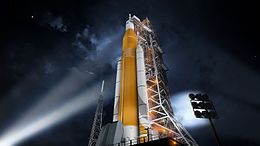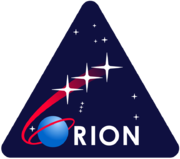Exploration Mission 1

Artist concept of SLS Block 1 configuration on launchpad
|
|
| Mission type | Lunar Orbital Test Flight |
|---|---|
| Operator | NASA/ESA |
| Mission duration | 3 Weeks |
| Spacecraft properties | |
| Spacecraft type | Orion MPCV |
| Start of mission | |
| Launch date | September 30 2018 (planned) |
| Rocket | SLS Block 1 |
| Launch site | Kennedy LC-39B |
| End of mission | |
| Landing date | October 2018 (planned) |
| Landing site | Pacific Ocean |
| Orbital parameters | |
| Reference system | Selenocentric |
| Period | 6 Days |
| Moon orbiter | |
| Orbital insertion | October 2018 (planned) |
|
Orion program
|
|
Exploration Mission 1 or EM-1 (previously known as Space Launch System 1 or SLS-1) is the first planned flight of the Space Launch System and the second flight of the Orion Multi-Purpose Crew Vehicle. The launch is planned for September 30, 2018 from Launch Complex 39B at the Kennedy Space Center. The Orion spacecraft is planned to spend approximately 3 weeks in space, with 6 days of this in a retrograde orbit around the Moon. It is planned to be followed by Exploration Mission 2 in 2021.
The Block 1 version of SLS used on this mission will consist of two five-segment Solid Rocket Boosters, four RS-25D engines built for the Space Shuttle program and an Interim Cryogenic Propulsion Stage. EM-1 is intended to demonstrate the integrated spacecraft systems prior to a crewed flight, and in addition, test a high speed reentry (11 km/s) on Orion's thermal protection system.
On January 16, 2013, NASA announced that the European Space Agency would build Orion's service module based on its Automated Transfer Vehicle, so the flight could also be regarded as a test of ESA hardware as well as American, and of how the ESA components interact with the American Orion components.
The Exploration Flight Test 1 (EFT-1) flight article was consciously constructed in a way that if all the missing components (seats, life support systems) were added, it would not meet the mass target. It was planned that subsequent capsules would be modified to be lighter, based on manufacturing experience.
...
Wikipedia

